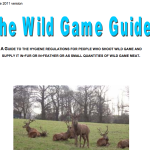A number of recent discussions and presentations have highlighted the confusion over game meat laws. Although it has been 11 years since the overhaul of game meat and game dealing rules many people are still not aware of the regulations as they currently stand.
So… what do these not so new changes mean to us and how do they affect “how we have always done it!”, especially for Deer Stalkers, Managers, Game dealers and the consumer..? David Mullen explains
Who are Primary Producers?
The EU food hygiene regulations regard shooting wild game for human consumption as a primary production activity. So from the individual stalker who shoots game alone, a game shoot, a hunting party all the way to an estate which organises all disciplines of game shooting and stalking are all primary producers.
Primary products in the wild game sector are the products of hunting, for example in-fur and in- feather game that has undergone “no more than any necessary preparation that is part of normal hunting practice.” This does not have to be done in the field, but can be carried out in game larders.
Any primary producer supplying an approved game handling establishment (AGHE) must:
- Ensure a trained person is present and completes relevant documentation
- Be registered with the Local Authority under the registration of food businesses requirement
- Comply with the food business operator’s responsibilities, including both the general hygiene provisions for primary production in Regulation 852/2004 and the specific provisions for the initial handling of large/small wild game in Regulation 853/2004 when it is subsequently supplied to an Game Dealer
- Meet the traceability requirements of Regulation 178/2002
PRIMARY PRODUCER EXEMPTION
There is an exemption from the above rules when supply involves small quantities of in-fur/in- feather carcases supplied either direct to the final consumer and/or to local retailers that directly supply the final consumer.
In the UK these terms can currently be interpreted as follows;
Small quantities are now regarded as self-defining because demand for in-fur/in-
feather carcasses from final consumers and local retailers is limited.
Local is within the supplying establishment’s own county plus the greater of either the neighbouring county or counties or 50 km/30 miles from the boundary of the supplying establishment’s county.
Direct supply to the final consumer is not restricted by what is local. An individual or an estate can supply final consumers who order from them via the internet/mail order as well as those who collect themselves from you.
Own Use
If the venison is for your own consumption, there is no requirement to be a trained hunter or to be registered as a food business, but you should still make yourself aware of notifiable diseases, their indicators, and what to do if you were to suspect them
What about selling Venison to a Game Dealer?
To supply venison to a Game Dealer all animals must be inspected by a trained hunter.
The trained hunter would normally be the stalker, however, if the stalker is not a trained hunter, there is the option of the stalker culling the deer but not gralloching or inspecting it. They must however observe the animals actions prior to culling (anti mortem), and report any abnormal behaviour to the trained hunter who must be present at the gralloch and must inspect the carcass and viscera.
Following the gralloch and inspection a numbered declaration must be attached by the trained hunter to each carcass, stating that, following an examination, the animal has been found to be free of any abnormal characteristics, did not display any abnormal behaviour and is free from environmental contamination. If there is evidence of abnormalities, etc, but the carcass is still being submitted to the Game Dealer, abnormalities should be indicated by the trained hunter. This can be achieved by using the declaration form or tag to record this information but by striking through the declaration statement itself. In all cases the date, time and place of killing should be indicated.

How do I become a trained Hunter?
Since December 2005 the requirements of EU Regulation 853/2004 (Wild Game Meat) have been an integral part of the DSC Level 1, so achieving the DSC Level 1 certificate from that date provides proof that holders have the knowledge required by the legislation for large wild game. Additionally there are a number of stand-alone courses that cover the requirements of the regulations.
The full Food Standards Agency Wild Game Meat guidance can be found here
Additional Information can also be found in the Best Practice Guidelines
